Tauopathies: new perspectives and challenges
- PMID: 35392986
- PMCID: PMC8991707
- DOI: 10.1186/s13024-022-00533-z
Tauopathies: new perspectives and challenges
Abstract
Background: Tauopathies are a class of neurodegenerative disorders characterized by neuronal and/or glial tau-positive inclusions.
Main body: Clinically, tauopathies can present with a range of phenotypes that include cognitive/behavioral-disorders, movement disorders, language disorders and non-specific amnestic symptoms in advanced age. Pathologically, tauopathies can be classified based on the predominant tau isoforms that are present in the inclusion bodies (i.e., 3R, 4R or equal 3R:4R ratio). Imaging, cerebrospinal fluid (CSF) and blood-based tau biomarkers have the potential to be used as a routine diagnostic strategy and in the evaluation of patients with tauopathies. As tauopathies are strongly linked neuropathologically and genetically to tau protein abnormalities, there is a growing interest in pursuing of tau-directed therapeutics for the disorders. Here we synthesize emerging lessons on tauopathies from clinical, pathological, genetic, and experimental studies toward a unified concept of these disorders that may accelerate the therapeutics.
Conclusions: Since tauopathies are still untreatable diseases, efforts have been made to depict clinical and pathological characteristics, identify biomarkers, elucidate underlying pathogenesis to achieve early diagnosis and develop disease-modifying therapies.
Keywords: Biomarkers; Genetics; Neurodegeneration; Tauopathies; Therapeutics.
© 2022. The Author(s).
Conflict of interest statement
Not applicable.
Figures




References
Publication types
MeSH terms
Substances
LinkOut - more resources
Full Text Sources
Other Literature Sources
Medical
Research Materials

